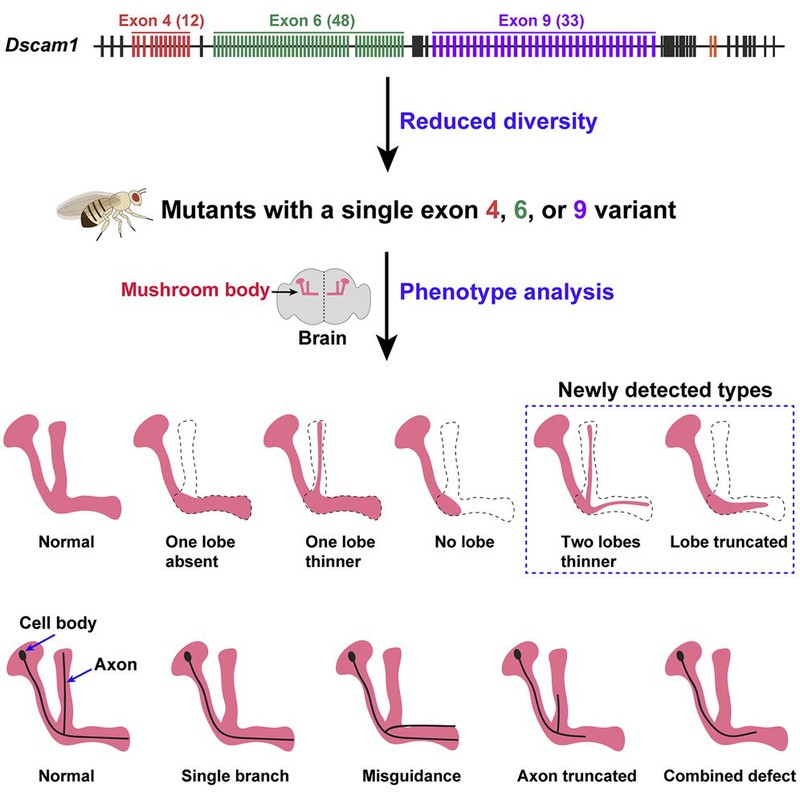Professor Yongfeng Jin's group from the College of Life Sciences, Zhejiang University published an article in Current Biology titled 'Self-avoidance alone does not explain the function of Dscam1 in mushroom body axonal wiring.' The study shows that the traditional self-avoidance model is insufficient to explain the mechanism of variable splicing of Drosophila Dscam1 in mushroom body (MB) axonal development.
Cell adhesion molecules play an important role in regulating neuronal circuits, including two classic examples: the Drosophila Down syndrome cell adhesion molecule (Dscam1) and pro-calmodulin (Pcdh) in mammals. Drosophila Dscam1 produces 38,016 protein isoforms by variable RNA splicing that is mutually exclusive and is described in many textbooks as a classic example of variable RNA splicing. Genetic analyses have shown that Dscam1 isoform diversity is required for nervous system development.
The classical model for the function of Dscam1 isoform diversity is primarily the neuronal self-avoidance model proposed by Professor Lawrence Zipursky (Nature, 2007; 2009). This model assumes that each neuron randomly expresses between 10 and 50 Dscam1 isoforms, giving a unique identity label. In this way, subtype-specific homophilic interactions mediate neuronal self-avoidance and discrimination between neurons that do not know themselves. However, the extent to which this conventional model can explain the neural function of Dscam1 subtype diversity remains unclear.
In this study, Professor Jin and his team constructed a series of mutants using CRISPR-Cas9 technology. Surprisingly, the mutant mushroom bodies exhibited a high frequency of novel phenotypic defects with shortened lobes and thinning of both lobes. Phenotypic analysis of individual neuron also revealed significant growth, branching, and segregation defects in the sister branches of the MB axons. In this way, these newly discovered defective phenotypes in MB neurons cannot be explained by the traditional model of Dscam1-mediated self-avoidance (Nature, 2007; 2009). Conversely, these newly discovered defective phenotypes are largely insufficient to support the traditional model of Dscam1-mediated self-avoidance in axon branching. The results of this study not only revise and extend previous views on the mechanisms of action of Dscam1 isoforms, but also provide new insights into the biological functions of tens of thousands of Dscam1 isoforms.

The work could be accessible at Self-avoidance alone does not explain the function of Dscam1 in mushroom body axonal wiring: Current Biology (cell.com).
About Dr Yongfeng Jin
Dr Jin graduated from Zhejiang Agricultural University in 1997 and became a professor in College of Life Sciences, Zhejiang University from 2004. He is currently an Adjunct Professor of Shanghai Institute for Advanced Study of Zhejiang University (SIAS).
Dr Jin’s research interests include RNA processing and editing, New non-coding RNA function andmechanism, Silkworm expressing cholera toxinB subunit-insulin fusion protein against autoimmune diabetes and Alzheimer's disease and its functional mechanism.
About SIAS
Shanghai Institute for Advanced Study of Zhejiang University (SIAS) is a jointly launched new institution of research and development by Shanghai Municipal Government and Zhejiang University in June, 2020. The platform represents an intersection of technology and economic development, serving as a market leading trail blazer to cultivate a novel community for innovation amongst enterprises.
SIAS is seeking top talents working on the frontiers of computational sciences who can envision and actualize a research program that will bring out new solutions to areas include, but not limited to, Artificial Intelligence, Computational Biology, Computational Engineering and Fintech.
Acknowledgement: The original draft of this article was provided by College of Life Sciences, ZJU.

